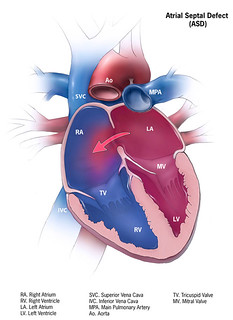I am posting this to raise awareness about Congenital Heart Defect (CHD). CHD awareness may save a life, it could be you or it could be someone that you know. In the recent years, you might have heard heart related death in middle aged Indian men and women more often. You likely heard the terms “Heart attack” or “Cardiac arrest” more than “Heart failure”. Heart failure happens when the heart cannot keep up with its workload. Lets see in detail.
CONGENITAL HEART DEFECT (CHD)
"Congenital" means "present from birth". CHD is one or more abnormalities in the heart's structure that one is born with.
It may produce symptoms at birth, during childhood and sometimes not until adulthood.
In USA, 1 in 150 adults are expected to have some form of CHD. I believe the statistics is similar in India as well.
There are several (20+) types of defects. Lets learn more about the most frequently diagnosed CHD in adults known as Atrial Septal Defect (ASD). ASDs are twice as common in women as men!
ATRIAL SEPTAL DEFECT (ASD)

Image Courtesy of the Centers for Disease Control and Prevention, National Center on Birth Defects and Developmental Disabilities.
As you may know, the heart contains 4 chambers. 2 upper chambers: the right atrium RA, left atrium LA and 2 lower chambers: right ventricle RV, left ventricle LV.
The RA receives the deoxygenated blood which it then pumps down to the RV which in turn sends to the lungs. The LA receives the oxygenated blood which it pumps down to the LV which in turn sends to all body parts.
During the baby development inside the womb, the septum (wall) separating the two upper chambers of the heart will have several openings. They usually close during pregnancy or shortly after birth. If the opening does not close, a hole is left and it is called as an ASD.
ASD RISK
Normally, the pressure is higher on the left heart than the right heart, because of this the oxygenated blood gets pushed through the hole from LA and get mixed with the deoxygenated blood in RA, resulting in
1) Pulmonary arterial hypertension leading to arrhythmias.
2) Right-sided heart failure.
3) Stroke...etc,.
CAUSE
Most causes of CHDs are unknown, however multifactorial inheritence (environmental and genetic risk factors) may play a role.
SYMPTOMS
1) Heart murmur (the increased blood flow to the lungs creates a swishing sound)
2) frequent respiratory infections in children
3) shortness of breath
4) increased fatigue
5) fainting
6) irregular heartbeats
7) heart palpitations
8) decreased exercise tolerance or tiring easily.
TREATMENT
1) Cardiac Catheterization – a non-invasive procedure in which the ASD/hole is sealed by implanting a closure device.
2) Open Heart surgery – in which small holes are fixed by sutures, larger defects are fixed with a special patch that covers the hole.

No comments:
Post a Comment